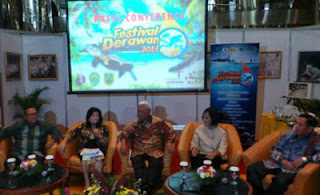The Raja Ampat Wonderful Indonesia
Raja Ampat Islands - Archipelago in Indonesia. Located off the northwest tip of Bird's Head Peninsula on the island of New Guinea, in Indonesia's West Papua province, Raja Ampat, or the Four Kings, is an archipelago comprising over 1,500 small (Wikipedia) in Province: West Papua
There are some facts about the Raja Ampat that you have to know. It has:
1,511 species of reef fish in the Bird’s Head Seascape;
1,320 species of reef fish;
75% of well-known coral species in the world;
10 times the number of hard coral species found in the entire Caribbean;
In the Birds Head Seascape there are 600 species of hard coral recorded;
5 species of endangered sea turtles;
57 species of Mantis Shrimp;
13 species of Marine Mammals;
And 27 species of endemic reef fish found only in that area
The Conservancy congratulates the people of Misool for their achievement!
Located in the Coral Triangle, the heart of the world’s coral reef biodiversity, the seas around the Raja Ampat Islands hold perhaps the richest variety of species in the world, including an incredible 75 percent of all known coral species.
But Raja Ampat’s abundant natural resources are endangered by destructive fishing practices, poor land use practices and the targeting of endangered species.
The Conservancy is working in close partnership with the government, communities, NGOs and the private sector to find solutions to those problems and protect Raja Ampat's extraordinary spectrum of life.
A TROVE OF WONDERS
The Raja Ampat archipelago encompasses 15,000 square miles of land and sea off the northwestern tip of the Indonesia province of Papua. Its four large islands — Waigeo, Batanta, Salawati and Misool — shelter an incredible array of terrestrial species as well as valuable forests.
The region includes the Pacific’s most important Leatherback Turtle nesting site. Offshore reefs protect an astounding 1,427 species of fish, as well as more than 550 species of coral. Some of these reefs have proven to be particularly resilient, and include coral-building resources that help sustain the entire Coral Triangle, making its protection all the more vital.
Raja Ampat’s wealth of resources faces an equally varied array of threats:
Destructive fishing practices such as dynamite and poison fishing, which harm reefs
The targeting hunting of vulnerable species, including turtles, sharks, crocodiles, groupers and Napoleon wrasse
Deforestation, which taxes the region’s resources and thins the region’s ecologically vital stands of vegetation
Rapid development and poor land use practices, which diminish and damage marine environments
AN ONGOING PARTNERSHIP
The Nature Conservancy has been actively working with local government, communities and other partners like World Wildlife Fund and Conservation International toward Raja Ampat’s protection for the past decade. Our main goal: to ensure the archipelago remains one of the world’s most biodiverse regions while sustaining the valuable natural resources Raja Ampat’s people need to keep their livelihoods. We are:
Helping to maintain Indonesia’s first network of Marine Protected Areas (MPAs), which span an area of 4,500 square miles
Incorporating MPA management into long-term planning and policy
Creating education opportunities and raising awareness of marine habitats and resources in local communities
Those activities have led to important outcomes. In 2010, the Raja Ampat government became the first Indonesian regency to declare its waters a shark sanctuary and prohibit the capture and killing of sharks, rays, dugong and turtles. And ongoing monitoring efforts are having a profound impact on the way the region protects its crucial coral reefs.
Marine protected areas like the one in southeast Misool have mobilized the surrounding villages. And our education work — like the Kalabia, a 100-foot sailing classroom program run jointly by the Conservancy and Conservation International — is encouraging resource protection at the family level. In communities like these, conservation activities aren’t merely a part of villagers’ identities — they’re also key to their survival.
In December 2009, an ecological survey assessed the health of Misool’s coral reef resources and led to the development of a more robust planning strategy for the region’s protected areas. Projects like these are essential for helping the region adapt to climate change and maintaining the many plants and animals that make Raja Ampat one of the most unique places on earth.
Set sail with two of the Conservancy’s top marine scientists — Sangeeta Mangubhai and Joanne Wilson -- as they lead an expedition to Raja Ampat.
Source: http://www.nature.org/
#WonderfulIndonesia




Comments
Post a Comment